The marker points to the location of Nikopolis.
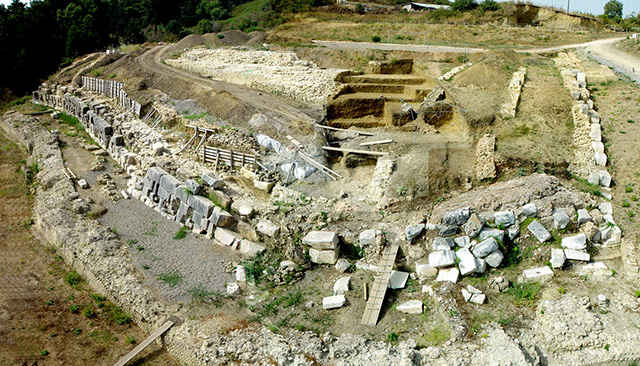 The sloping site of the monument north of the main ancient city of Nikopolos, Greece, was first explored in 1805 by William M. Leake. The newly discovered ruins of the monument was then partially excavated by various teams during the early decades of the 20th century. A large clearing of the visible remains was undertaken by William M. Murray and Photios M. Petsas during the 1980s. A more complete excavation and documentation of the victory monument was then undertaken from 1995 - 2003 under the direction of Konstantinos L. Zachos (see the aerial view of the excavation at the left; image courtesy of Konstantinos Zachos; hover over to enlarge). Zachos' fieldwork exposed the full extent of the structure built by Octavian upon his defeat of the naval forces commanded by Mark Antony and Cleopatra at the Battle of Actium, in 31 BCE.
The sloping site of the monument north of the main ancient city of Nikopolos, Greece, was first explored in 1805 by William M. Leake. The newly discovered ruins of the monument was then partially excavated by various teams during the early decades of the 20th century. A large clearing of the visible remains was undertaken by William M. Murray and Photios M. Petsas during the 1980s. A more complete excavation and documentation of the victory monument was then undertaken from 1995 - 2003 under the direction of Konstantinos L. Zachos (see the aerial view of the excavation at the left; image courtesy of Konstantinos Zachos; hover over to enlarge). Zachos' fieldwork exposed the full extent of the structure built by Octavian upon his defeat of the naval forces commanded by Mark Antony and Cleopatra at the Battle of Actium, in 31 BCE.
That naval battle was one of the great pivotal moments in the history of the world. During the late 1st century BCE, Octavian (Gaius Julius Caesar Octavianus, who was specifically named as successor by Julius Caesar) controlled the western territories of the Roman world, while Mark Antony and his allies controlled the eastern portions. In 31 BCE, Mark Antony and Cleopatra fought Octavian in what became the crucial naval battle in a war for control of the entire ancient Roman world. Their two fleets clashed along the western coast of Greece (just outside the Ambracian Gulf; see the Google Maps image above), where a nearby cape (Actium) gave the battle its name.
Antony and Cleopatra's fleet consisted primarily of massive quinqueremes while Octavian's fleet was made up mainly of smaller Liburnian vessels. Antony’s ships had a cataphract design, in which oarsmen are protected on the sides and above from missile fire. Octavian’s vessels used the aphract design, in which oarsmen are unprotected, unless by a leather screen along the side of the ship. Antony's quinqueremes had distinct advantages: (1) they were taller allowing soldiers to shoot or attack down upon an enemy; and (2) they had bronze plates which protected them from ramming. Conversely, the Liburnian ships of Octavian's fleet were much more maneuverable. The primary tactic of Roman naval battles was to maneuver into position to ram and sink an opponent's ship. Since the quinqueremes could not maneuver quickly enough to ram the faster Liburnian ships and the Liburnians could not do much damage even if they did ram the plated quinqueremes the battle progressed slowly, with Octavian eventually gaining the upper hand. We're not sure exactly what happened, but ancient Roman writers tell us that Cleopatra and some of her ships fled the battle, followed soon after by Antony and some of his ships. By the end of just one day's fighting, Octavian's navy had so completely destroyed their rival's warships that Antony and Cleopatra's forces never recovered. With his decisive victory, Octavian became undisputed ruler of the Mediterranean. In 27 BCE, the Roman Senate bestowed the name Augustus on Octavian.
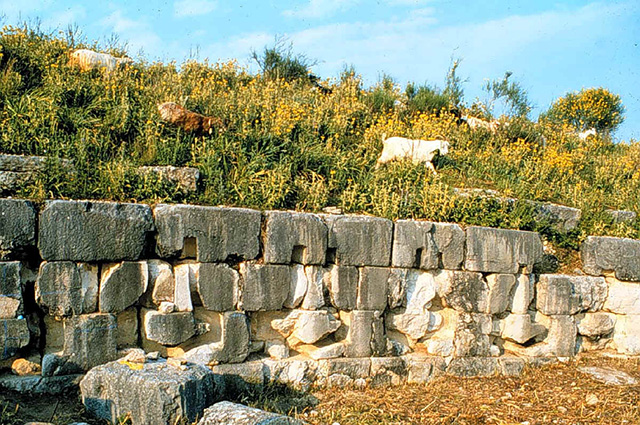 Two years after his victory, Augustus built a trophy monument, in thanksgiving for his victory, on the heights overlooking the waters where the battle had been waged. He also founded a new city, Nikopolis (Victory City) at the base of the hill. The monument was formally dedicated to Mars and Neptune (the hill on which the monument was built was probably sacred to Apollo). The monument has a large stone podium, into the front side of which his masons cut sockets (extending across the length for about 70m) which hold the bronze ramming prows from Antony and Cleopatra's ships. The rams were hauled up from the sunken ships and inserted into specially cut sockets uniquely shaped specifically for each ram.
Two years after his victory, Augustus built a trophy monument, in thanksgiving for his victory, on the heights overlooking the waters where the battle had been waged. He also founded a new city, Nikopolis (Victory City) at the base of the hill. The monument was formally dedicated to Mars and Neptune (the hill on which the monument was built was probably sacred to Apollo). The monument has a large stone podium, into the front side of which his masons cut sockets (extending across the length for about 70m) which hold the bronze ramming prows from Antony and Cleopatra's ships. The rams were hauled up from the sunken ships and inserted into specially cut sockets uniquely shaped specifically for each ram.
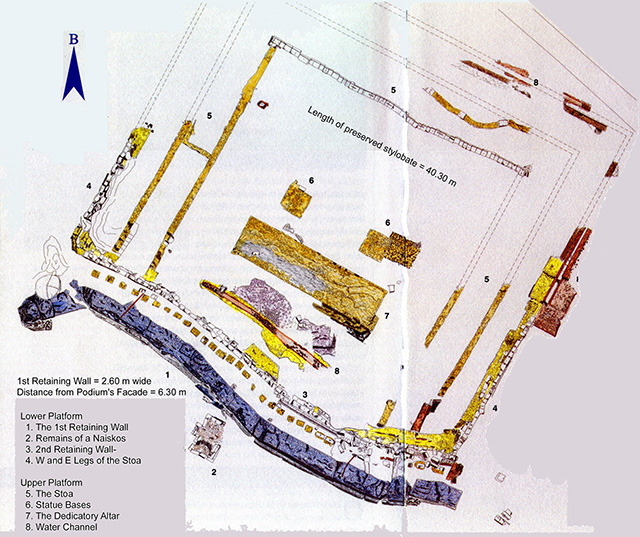 The rest of the trophies from the battle were most likely housed in the U-shaped stoa on top of the podium (see the excavation plan at the left; image courtesy of Konstantinos Zachos; hover over to enlarge). Over the centuries, the monument fell into ruins, and all the bronze rams have disappeared. Since its discovery, archaeologists have wondered what the original monument might have looked like with the massive enemy rams ships protruding from the face of the podium, in full view from Nikopolis below. Such a visualization was the task brought to Learning Sites by the Institute for the Visualization of History and researcher William Murray (University of South Florida).
The rest of the trophies from the battle were most likely housed in the U-shaped stoa on top of the podium (see the excavation plan at the left; image courtesy of Konstantinos Zachos; hover over to enlarge). Over the centuries, the monument fell into ruins, and all the bronze rams have disappeared. Since its discovery, archaeologists have wondered what the original monument might have looked like with the massive enemy rams ships protruding from the face of the podium, in full view from Nikopolis below. Such a visualization was the task brought to Learning Sites by the Institute for the Visualization of History and researcher William Murray (University of South Florida).
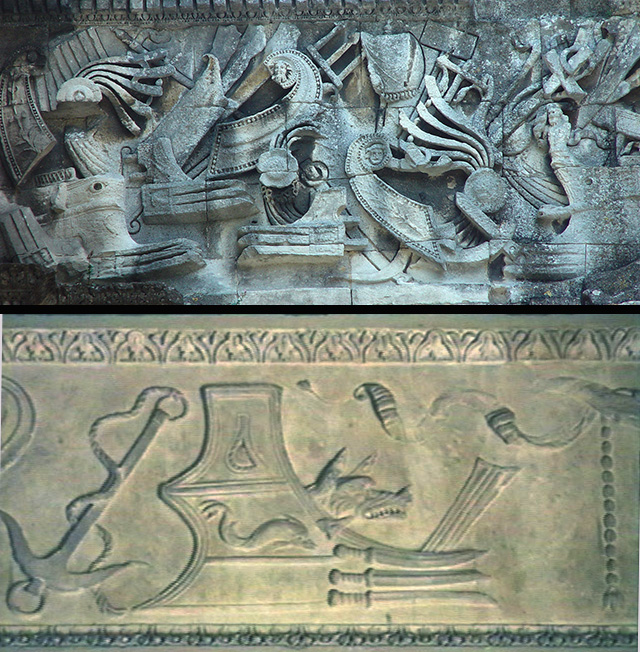 Several bits of evidence, besides the monument itself, were crucial to our digital re-creation, which began with a 3D reconstruction of one of the bronze rams that once protruded from the sockets in the podium's facade.
Several bits of evidence, besides the monument itself, were crucial to our digital re-creation, which began with a 3D reconstruction of one of the bronze rams that once protruded from the sockets in the podium's facade.
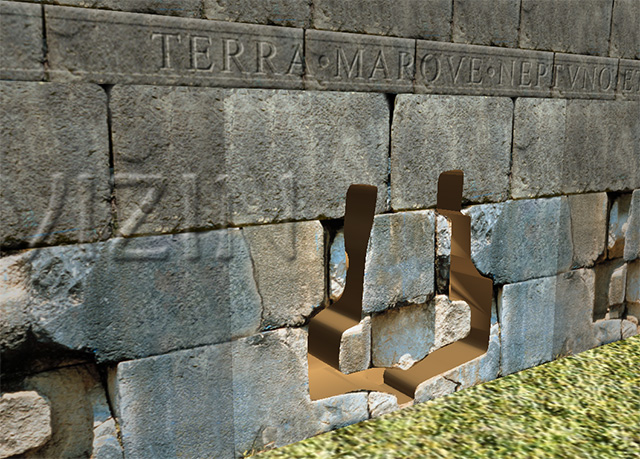 Once we had examined all the evidence and constructed a 3D computer model of the Athlit ram, we compared the results with the dimensions, shape, and construction of the sockets at Actium. The Actium sockets preserve the size and shape of the actual rams at a single specific and identifiable portion along their length. For a test, we chose a single socket (number 4) and modeled the socket and part of the wall of the monument's podium (see the preliminary image at the left; hover over to enlarge).
Once we had examined all the evidence and constructed a 3D computer model of the Athlit ram, we compared the results with the dimensions, shape, and construction of the sockets at Actium. The Actium sockets preserve the size and shape of the actual rams at a single specific and identifiable portion along their length. For a test, we chose a single socket (number 4) and modeled the socket and part of the wall of the monument's podium (see the preliminary image at the left; hover over to enlarge).
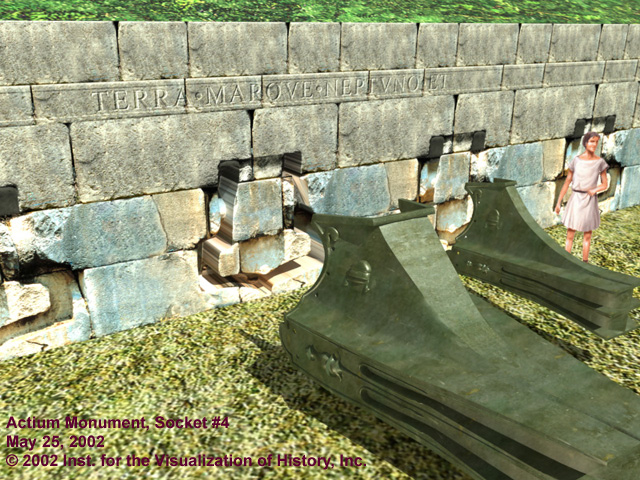 Working with our 3D computer model of the Athlit ram as a guide, we "morphed" that Socket 4 ram's model to fit into its place at Actium. We ensured that any change in the shape of a section of the new ram (made in order to fit into the socket) was reflected in actual deformation or proportional enlargement across the entire ram (see the image at the left showing the new socket 4 ram with the original Athlit ram next to it; hover over to enlarge). This was necessary to maintain the overall integrity of its shape in relation to how these rams originally fit onto the ship hulls.
Working with our 3D computer model of the Athlit ram as a guide, we "morphed" that Socket 4 ram's model to fit into its place at Actium. We ensured that any change in the shape of a section of the new ram (made in order to fit into the socket) was reflected in actual deformation or proportional enlargement across the entire ram (see the image at the left showing the new socket 4 ram with the original Athlit ram next to it; hover over to enlarge). This was necessary to maintain the overall integrity of its shape in relation to how these rams originally fit onto the ship hulls.
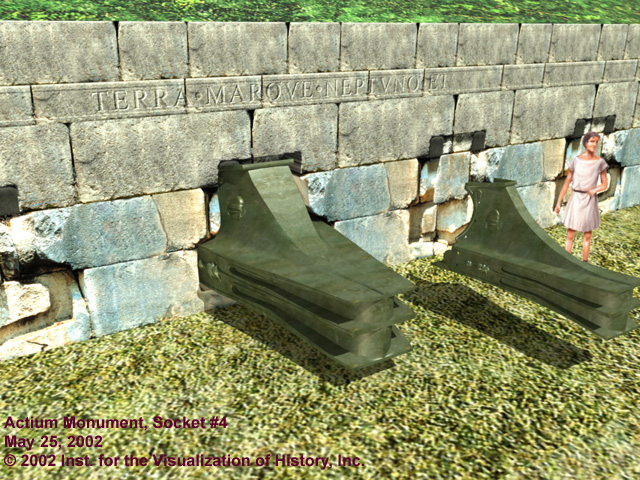 Using virtual reality, we could test--in real time--whether or not the new ram was beginning to fit into the socket we had modeled. The process of tweaking the ram model and testing it in the socket continued until we had a secure and tight fit (see the results at the left; hover over to enlarge). The model was further tweaked using the depictions of rams from the battle sculpted on the arch at Orange (see above), which we determined were probably the most accurate rendition of the actual rams, primarily due to the shape of the rear flap, with the distinctive inward curve. This curved shape matches the inner shape of the sockets at Actium and does not appear on other images of ancient rams. Nor does this feature exist on the Athlit ram. The resulting ram for Socket #4 at Actium is substantially larger and more massive than the Athlit ram, but accurately depicts, as closely as the evidence permits, the actual ram that once projected from that socket.
Using virtual reality, we could test--in real time--whether or not the new ram was beginning to fit into the socket we had modeled. The process of tweaking the ram model and testing it in the socket continued until we had a secure and tight fit (see the results at the left; hover over to enlarge). The model was further tweaked using the depictions of rams from the battle sculpted on the arch at Orange (see above), which we determined were probably the most accurate rendition of the actual rams, primarily due to the shape of the rear flap, with the distinctive inward curve. This curved shape matches the inner shape of the sockets at Actium and does not appear on other images of ancient rams. Nor does this feature exist on the Athlit ram. The resulting ram for Socket #4 at Actium is substantially larger and more massive than the Athlit ram, but accurately depicts, as closely as the evidence permits, the actual ram that once projected from that socket.
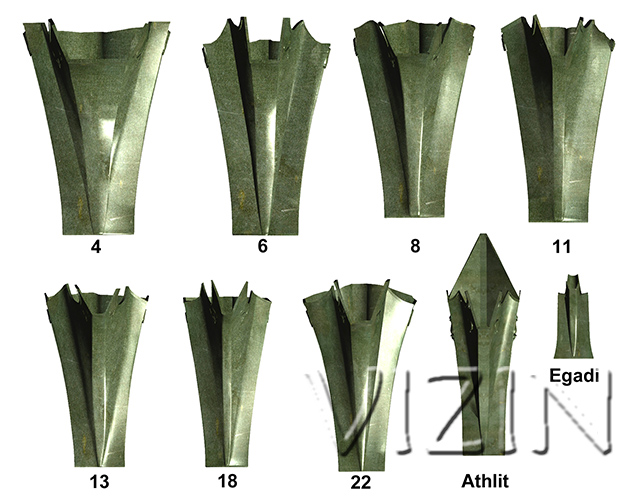 The process of tweaking rams to fit precisely into their corresponding sockets continued across the monument (see various samples at the left; compared to the Athlit ram; hover over to enlarge). In doing so, we began to get a good idea of the make up of Antony and Cleopatra's fleet, based on the statistical sampling of different rams found at Actium (which could be used by naval historians to compare with the descriptions of the ships found in ancient Roman writers' retelling of the battle).
The process of tweaking rams to fit precisely into their corresponding sockets continued across the monument (see various samples at the left; compared to the Athlit ram; hover over to enlarge). In doing so, we began to get a good idea of the make up of Antony and Cleopatra's fleet, based on the statistical sampling of different rams found at Actium (which could be used by naval historians to compare with the descriptions of the ships found in ancient Roman writers' retelling of the battle).
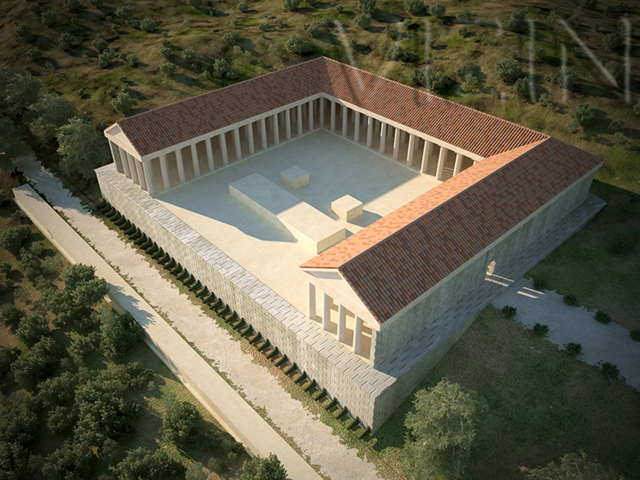 Eventually, based on evidence from the excavations and our work on shaping each ram and rebuilding the sockets, a visualization of the entire victory monument emerged (see the rendering at the left; hover over to enlarge). The podium facade has over 35 different rams protruding from it; a warning to anyone who might dare to challenge Rome's maritime supremacy.
Eventually, based on evidence from the excavations and our work on shaping each ram and rebuilding the sockets, a visualization of the entire victory monument emerged (see the rendering at the left; hover over to enlarge). The podium facade has over 35 different rams protruding from it; a warning to anyone who might dare to challenge Rome's maritime supremacy.
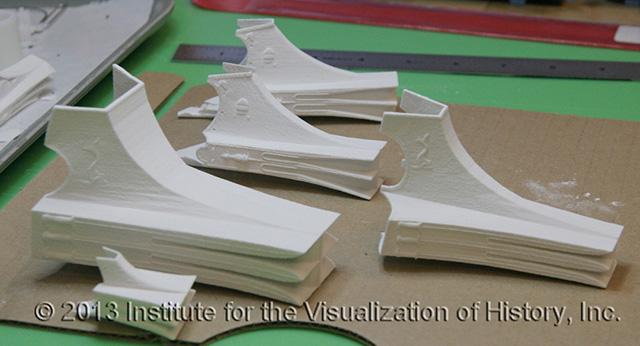 Investigations into the workings of the sockets and the methods used by the Romans to carve the sockets so precisely and individually and to set the rams securely in place did not stop with our virtual reality models. 3D printed scale replicas of rams and sockets (based on our 3D computer models) were created to test various theories and compare the features of different sized rams (see the image at the left, which shows the Athlit ram, and several rams from Actium; the larger rams are c.11cm long; hover over to enlarge).
Investigations into the workings of the sockets and the methods used by the Romans to carve the sockets so precisely and individually and to set the rams securely in place did not stop with our virtual reality models. 3D printed scale replicas of rams and sockets (based on our 3D computer models) were created to test various theories and compare the features of different sized rams (see the image at the left, which shows the Athlit ram, and several rams from Actium; the larger rams are c.11cm long; hover over to enlarge).
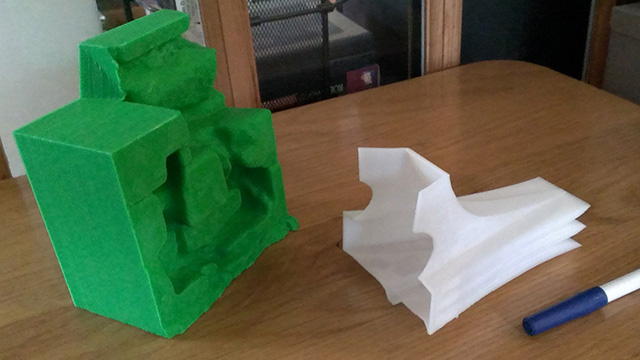
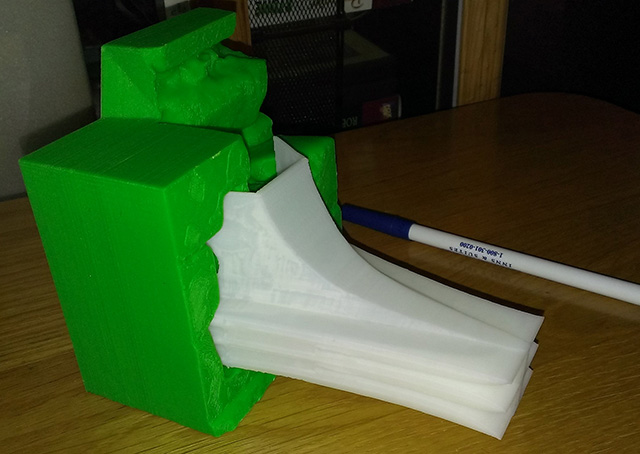 At the left are images of Socket and Ram 4 from Actium showing how tightly it fits into the socket (hover over to enlarge).
At the left are images of Socket and Ram 4 from Actium showing how tightly it fits into the socket (hover over to enlarge).
Paper Publications about the Battle
Carter, John M.
1970 The Battle of Actium: the rise and triumph of Augustus Caesar. London: Hamilton.
Lange, C.
2011 "The Battle of Actium: a reconsideration," The Classical Quarterly 61.2:608-23.
Murray, William M.
2002 "Reconsidering the Battle of Actium--Again," pp.339-60 in V. Gorman and E. Robinson, eds., Oikistes: studies in constitutions, colonies, and military power in the ancient world offered in honor of A. J. Graham. Leiden: Brill.
Paper Publications about the Monument
Murray, William M.
2013 "Augustus’s Victory Monument, 3D Modeling, and New Directions for Warship Research," in Speira , a Festschrift in honor of K. Zachos and A. Douzougli.
also available online.
Murray, William M. & Photios M. Petsas
1989 Octavian's Campsite Memorial for the Actian War. Special issue of the Transactions of the American Philosophical Society. New Series v.79.4:1-172.
Zachos, Konstantinos
2003 "The Tropaeum of the Sea-battle of Actium at Nikopolis: Interim Report." Journal of Roman Archaeology 16:64–92.
2001 "Excavations at the Actian Tropaeum at Nikopolis," pp.29-41 in Jacob Isager, ed., Foundation and Destruction: Nikopolis and Northwestern Greece, Aarhus, the Netherlands: Aarhus University Press.
Digital Resources